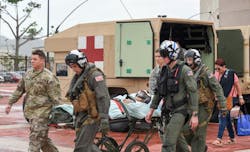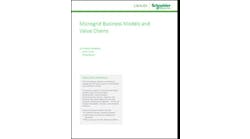In its struggle to quantify energy resilience, the microgrid industry tends to focus on economic damages from power outages: Perished goods, lost sales, diminished worker hours.
Now it has a new, disturbing data point: Loss of human life.
A Harvard study published last week in the New England Journal of Medicine estimates 4,645 deaths in Puerto Rico from Hurricane Maria.
Most of the deaths were not from the hurricane’s immediate ferocity, but a lingering aftermath that left large swaths of the island without power for months. This translated into lack of access to hospitals, medical devices and refrigeration for medications.
“Chronically ill patients are particularly vulnerable to disruptions in basic utilities, which highlights the need for these patients, their communities, and their providers to have contingency plans during and after disasters,” says the paper.
In fact, the study found interruption of medical care to be the primary cause of death.
Heightened interest in energy resilience
“This is one of the many reasons we are seeing more clients place resiliency high on the list of factors (ahead of pure economic criteria), driving an investment into comprehensive microgrids integrated with distributed energy systems that will add another layer of protection for its customers,” said Michael Bakas, Ameresco’s executive vice president, distributed energy.
“…we are seeing more clients place resiliency high on the list” — Michael Bakas, Ameresco
Storms like Hurricane Maria underscore a dangerous weakness in the contemporary world. We now rely on electricity for most of life’s essential needs: food, communications, transportation, healthcare. Sixty percent of US gross domestic product is tied to electricity, according to Homeland Security. But electric grids are vulnerable to domino-like failure. Damage to a single line or piece of equipment in one area can cause outages for miles.
This vulnerability became particularly apparent in August 2003 when a sagging line brushed a tree, an alarm system failed and 50 million people across multiple states and Canada lost power. Even worse, in India 620 million — nine percent of the world’s population — lost power in July 2012, a cascading event tied to the failure of backup safety systems.
That same year Superstorm Sandy hit the U.S. leaving parts of the Northeast in the dark for two weeks, and in all cutting power to more than 8 million people in 17 states. After that storm, the Northeast began to seriously look at decentralizing the grid and the modern day microgrid movement took off.
Microgrids ensure energy resilience by dividing the grid into segments, or pockets, of local energy. The microgrid can island from the main grid during a crisis so that it does not become part of a cascading failure. Using its local generating assets, the microgrid keeps the power flowing to nearby buildings.
Why not just back-up generators?
Many hospitals have back-up generators, including those in Puerto Rico, but they are more limited than microgrids. Back-up generators typically rely on fuel whose supply often runs low during a disaster because of delivery difficulties. Natural gas lines may break. Trucks carrying diesel may find roadways blocked.
Microgrids, on the other hand, typically do not rely on one fuel, but use multiple sources of energy so that they have redundancy. For example, many new microgrids use renewable energy (solar or wind) and energy storage, as well as fossil fuel generators.
Moreover, because back-up generators are used only during a crisis, if they aren’t working, it’s often not discovered until they are desperately needed. Microgrids run all the time, supplying power whether there is a grid outage or not, so are maintained and monitored often.
In addition, the ill aren’t always in hospitals. Many are at home or in more transitional facilities where they still count on electricity.
“Hospitals have mandatory back up generation for a reason, but when full communities are out of power for days, or even weeks, as seen after [hurricanes] Katrina, Sandy, and Maria, the most in need are often at the greatest risk. People in wheelchairs and many senior citizens become trapped in apartment buildings after these storms. Grocery stores and pharmacies close preventing people from getting food or medication,” said Michael Kilpatrick, vice president of power systems solutions, S&C Electric.
“People in wheelchairs and many senior citizens become trapped in apartment buildings after these storms.” — Michael Kilpatrick, S&C Electric
Credit U.S. Department of Defense
How to pay for energy resilience?
For these reasons, more and more hospitals, communities, businesses and utilities are looking at microgrids. But development has been slower than many would like. Last year’s round of hurricanes heightened the worry that the US remains unprepared. Puerto Rico entered the hurricane season June 1 with more microgrids than a year ago, but far from enough.
Even worse, a cyber terrorism threat looms over North America, with utilities and Homeland Security reporting frequent attempted attacks on the grid from enemy actors.
Given these dangers, what’s holding up more microgrid development?
A big problem is that neither industry nor government has yet to figure out how to monetize a key microgrid benefit: energy resilience, the ability to avert a power outage or quickly recover from it. Until a way exists to pay for this microgrid service, development may remain too niche to offer widespread protection.
Microgrid supporters often discuss this economic stumbling block. But they have yet to galvanize around a clear path forward.
The renewable energy industry faced a similar problem in its early years, as it tried to determine how to monetize what it called “environmental externalities,” the benefits of clean energy. Out of those discussions came a quasi-market solution known as the renewable portfolio standard (RPS), now instituted in about three-fifths of the US states. The standards vary by state, but generally a renewable energy plant receives credits for producing a certain amount of renewable energy. It can then sell the credits to utilities and retail suppliers who use them toward meeting state requirements that they provide a specified amount of energy from renewables.
It’s far too early to say if a mechanism similar to RPS would work for energy resilience. But it may be a path for states to explore. The military and others have noted that energy resilience is quickly becoming the new ‘green,’ in the sense that it’s an attribute that society now wants to infuse into its electric service. So some kind of credit trading around energy resilience may offer possibility.
Puerto Rico as a lesson for the rest of us
The Harvard study is the first to comprehensively examine the death rate in Puerto Rico following Hurricane Maria. More studies are planned and the final number may vary. The 4,645 figure represents a midpoint extrapolated from a random sample of 3,299 households. The actual range is 793 to 8,498 deaths.
Whatever the final number, clearly there were many more deaths than the 64 officially reported by Puerto Rico’s government. This was known even before the study via information from relief workers and press reports. Whatever the final number — 1,000 or 8,000 — the deaths underscore the danger of losing electricity for prolonged periods, a warning that any society highly dependent on electricity needs to heed. Figuring how to monetize energy resilience isn’t just a microgrid industry problem; it’s one for all communities and governments in an age where having electricity is — without exaggeration — a life and death matter.
Read more stories about the quest for energy resilience. Subscribe to the free Microgrid Knowledge newsletter.







